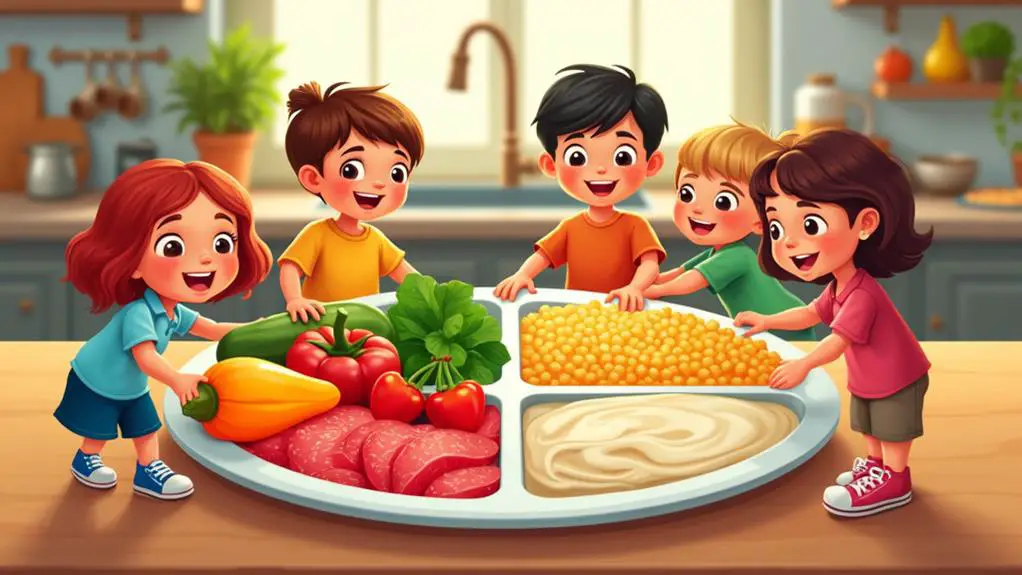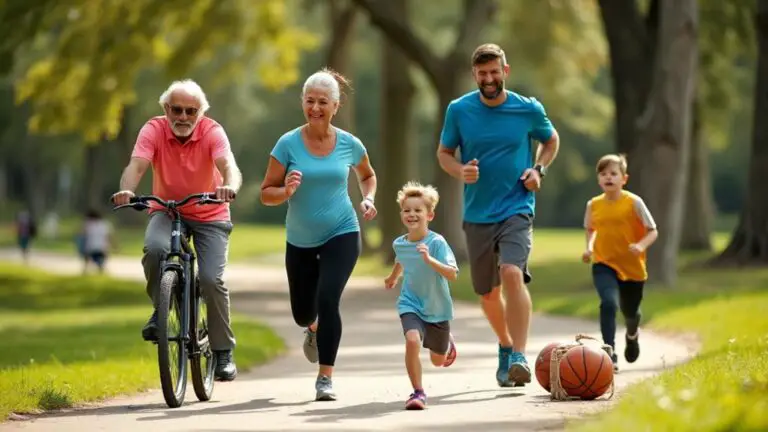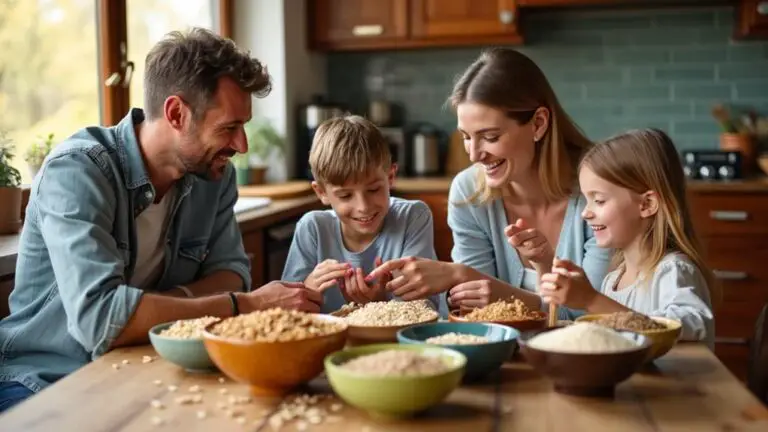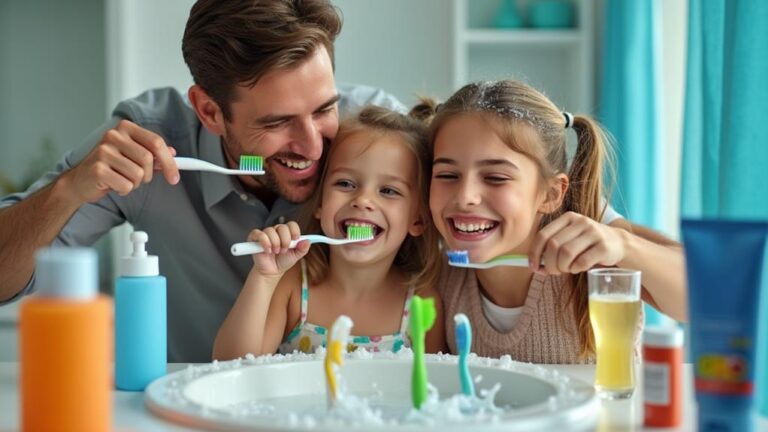Fun Ways to Teach Kids About the Food Groups
You can make learning about food groups fun and engaging for kids through interactive games, creative art projects, and hands-on cooking experiences. Try playing "MyPlate Bingo" or organizing a "Food Group Relay Race" to reinforce nutritional concepts. Get artistic with food group collages or edible art creations using fruits and vegetables. Involve children in meal preparation, like making salads or sandwiches, to teach them about balanced diets. Utilize educational technology resources, such as interactive websites and apps, to enhance their understanding. Incorporating physical activities like nutrition-themed obstacle courses can also make learning about food groups exciting and memorable. Discover even more innovative ways to turn nutrition education into an adventure.
Key Takeaways
- Use interactive games like "MyPlate Bingo" and "Food Group Relay Race" to engage kids in learning food categories.
- Create edible art projects using fruits and vegetables to combine creativity with hands-on nutritional learning.
- Involve children in cooking activities like making salads or "Bread in a Bag" to teach about different food groups.
- Utilize educational technology resources such as interactive websites and apps for engaging digital learning experiences.
- Incorporate grocery shopping trips to teach kids about food selection, label reading, and making healthy choices.
Interactive Food Group Games
When it comes to teaching kids about food groups, interactive games are a fantastic way to make learning both fun and memorable. You can engage children with "MyPlate Bingo," which helps them identify and remember the five food groups through exciting gameplay.
For a more active approach, try the "Food Group Relay Race," encouraging teamwork as kids categorize food items into their respective groups.
Don't forget digital options like the "BAM! Dining Decision App," which offers game-based learning about healthy eating choices.
"Food Group Pictionary" taps into children's creativity, allowing them to draw and guess different foods while reinforcing their knowledge.
Finally, organize scavenger hunts that challenge kids to find and categorize food items, providing hands-on learning and excitement about nutrition.
These interactive games make learning about food groups an enjoyable experience for children.
Creative Art Projects
You can spark your students' creativity while reinforcing their knowledge of food groups through engaging art projects.
Try having them create colorful food group collages, where they cut out and arrange images of various foods into their respective categories.
For a hands-on approach, encourage your class to make edible art creations using real fruits and vegetables, allowing them to explore textures and colors while learning about healthy food choices.
Food Group Collages
Through the creative process of making food group collages, kids can immerse themselves in the world of nutrition while having fun. You'll find this activity not only reinforces their understanding of the five food groups but also enhances their creativity. Encourage students to draw or paste pictures of various foods, categorizing them into fruits, vegetables, grains, proteins, and dairy. This hands-on approach helps them visualize a balanced diet and its importance.
| Food Group | Examples |
|---|---|
| Fruits | Apples, Bananas |
| Vegetables | Carrots, Broccoli |
| Grains | Bread, Rice |
| Proteins | Chicken, Beans |
To emphasize healthy eating, include drawings of people exercising alongside the food groups. This collaborative project fosters teamwork and communication skills as students work together to create a visual representation of nutritious choices. By engaging in this activity, children learn to appreciate the benefits of consuming a varied diet for ideal health.
Edible Art Creations
Ever wondered how to make learning about nutrition a deliciously fun experience? Try edible art creations with your kids! This hands-on activity allows children to sculpt food masterpieces using fruits, vegetables, and other ingredients. It's a creative way to explore food groups while developing artistic skills.
Encourage your little ones to make fruit and vegetable animals or design pizza faces. These projects help them visually identify and categorize foods, enhancing their understanding of balanced diets.
As they work, discuss the nutritional value of each ingredient, promoting critical thinking about food choices. Use a variety of colorful foods to make the experience visually engaging and emphasize the importance of diverse eating habits.
Turn it into a group activity to foster teamwork and social skills alongside nutritional education. Your kids will love this tasty approach to learning about food groups!
Hands-On Cooking Experiences
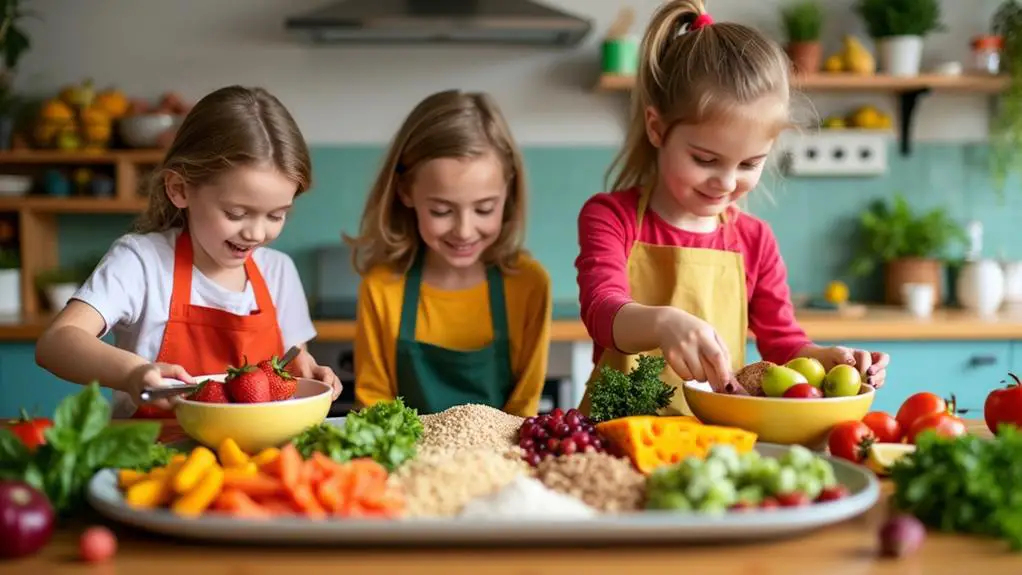
Hands-on cooking experiences offer a delightful way to teach kids about food groups. You can involve your children in making simple meals like salads and sandwiches, allowing them to actively engage with different food groups and understand their nutritional value. While cooking, encourage them to assess plate balance by including a variety of food groups, fostering an appreciation for a balanced diet.
These activities not only teach essential life skills but also boost your child's confidence in the kitchen. Try the "Bread in a Bag" method to teach about grains and provide a sense of accomplishment. Here's a quick guide to hands-on cooking experiences:
| Activity | Skills Learned | Food Groups Covered |
|---|---|---|
| Salad Making | Chopping, Mixing | Vegetables, Proteins |
| Sandwich Assembly | Spreading, Layering | Grains, Proteins, Dairy |
| "Bread in a Bag" | Measuring, Kneading | Grains |
Educational Technology Resources
In today's digital age, educational technology resources offer exciting ways to teach kids about food groups. You'll find interactive websites and games like Team Nutrition MyPlate eBooks that engage children in learning about the five food groups.
The BAM! Dining Decisions App makes healthy eating choices fun through gameplay, allowing kids to understand the nutritional value of their selections.
BrainPOP's animated videos and quizzes simplify complex nutrition concepts for young learners. USDA resources feature activity sheets and quizzes focused on breakfast, reinforcing the importance of starting the day with a balanced meal.
Food Hero: Kids provides stories, videos, and interactive elements to further engage children in nutrition education. These educational technology resources make learning about food groups enjoyable and accessible, helping kids develop healthy eating habits through interactive and engaging digital experiences.
Physical Activities for Nutrition Learning
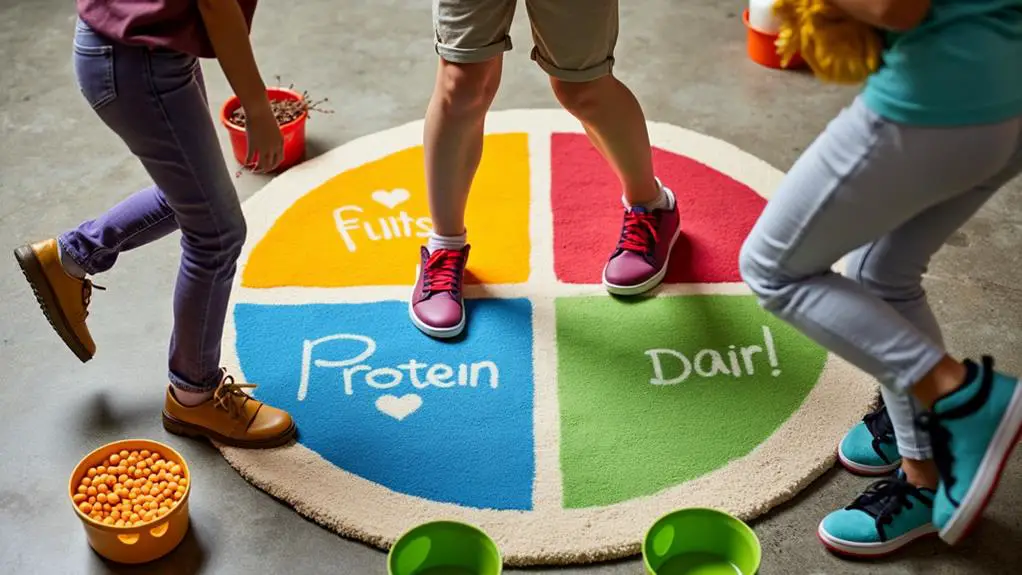
You'll find that combining physical activities with nutrition education creates an engaging learning experience for kids.
Active food group games, like "Nutrition Tag" or "Food Group Relay Race," get children moving while reinforcing their understanding of different food categories.
Nutrition-themed obstacle courses can also be a fun way to challenge kids physically and mentally as they navigate through tasks related to various food groups.
Active Food Group Games
Gone are the days of dull nutrition lessons! Active food group games are revolutionizing how kids learn about healthy eating. You'll love watching children engage in fun activities like "Food Group Relay Races" and "Nutrition Scavenger Hunts" that combine physical movement with nutritional knowledge.
Create a "Healthy Eating Obstacle Course" to challenge kids' fitness and food group understanding. Try the "Fruit and Vegetable Toss" game to improve coordination while learning about different foods. Don't forget the energetic "MyPlate Freeze Dance" for a musical twist on nutrition education.
| Game | Skill Developed |
|---|---|
| Relay Races | Speed & Recognition |
| Scavenger Hunt | Exploration & Memory |
| Obstacle Course | Agility & Categorization |
These interactive games make learning about food groups a thrilling experience, ensuring kids retain important nutritional information while having a blast.
Nutrition-Themed Obstacle Courses
Nutrition-themed obstacle courses offer a dynamic way to blend physical activity with food group education. You can create stations representing each food group, where kids complete physical challenges while learning about balanced diets. This interactive approach encourages children to engage in exercise while discussing the nutritional benefits of various food options.
To design an effective nutrition-themed obstacle course:
- Incorporate fruit stations with bean bag tossing activities
- Set up protein stations requiring jumping jacks to earn cards
- Create vegetable-themed crawling or hopping challenges
- Include dairy-related balancing or spinning tasks
These courses promote teamwork and communication as children work together to navigate challenges.
Family Meal Planning Challenges
Immerse yourself in family meal planning challenges to make learning about food groups an exciting adventure for kids. Encourage collaboration by having each family member contribute meal ideas from different food groups, promoting variety and balanced nutrition.
Incorporate weekly themes like "Meatless Monday" or "Taco Tuesday" to introduce diverse cuisines and healthy options. Set a budget to teach children about economics and making healthy choices within financial constraints.
Use a visual chart to track meals, helping kids understand the importance of including all food groups. Engage them in grocery shopping to enhance their understanding of food selection and label reading.
Conclusion
You've now got a toolbox full of fun ways to teach kids about food groups. Like a chef combining ingredients to create a delicious meal, you can mix and match these activities to suit your children's tastes. Remember, learning about nutrition doesn't have to be as dry as overcooked chicken. In fact, a study showed that interactive nutrition education can increase fruit and vegetable consumption by up to 25%. So, get creative and watch your kids' knowledge grow alongside their appetites for healthy eating!

